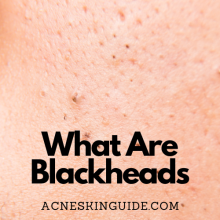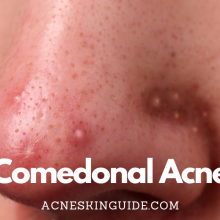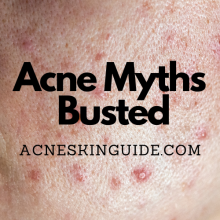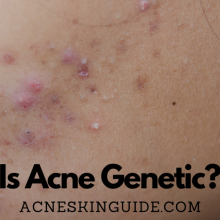What Causes Acne? The Truth About Acne Triggers | AcneSkinGuide
Summary of Answering What Causes Acne?
Acne is a common skin condition affecting millions, caused by a combination of factors that clog pores. Key culprits include hormonal fluctuations that increase oil production, accumulation of dead skin cells, overgrowth of acne-causing bacteria, inflammation, and genetic factors. Different types of acne like hormonal cystic acne, blackheads, and whiteheads can have specific triggers. Popular myths like diet, stress, and poor hygiene alone are debunked.
Other potential aggravators include medications, environment, excessive sweating, and harsh products. An inside-out approach combining targeted skincare, dietary tweaks, lifestyle adjustments, professional treatments when needed, and trying natural remedies can help get breakouts under control. Understanding the real root causes allows for a comprehensive treatment plan tailored to one’s unique acne triggers.
Our Top 3 Recommended Acne Treatment Products

#1 Paula's Choice Acne Treatment
The 3-step kit features a cleanser and exfoliating solution with 2% salicylic acid, as well as a 5% benzoyl peroxide treatment that effectively treats even severe acne, though the benzoyl peroxide can be drying. The kit delivers serious results for stubborn acne, despite its slightly higher price point compared to drugstore options. Check The Price Now
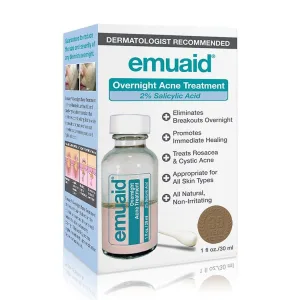
#2 EMUAID Overnight Acne Treatment
The EMUAID Overnight Acne Treatment features a two-phase solution, with an exfoliating first step to unclog pores and an intensive treatment gel that rapidly reduces inflammation, redness, and swelling of even severe, cystic breakouts, despite a slightly medicinal scent and higher price point compared to other options. Check The Price Now

#3 Differin Acne Treatment
The Differin 0.1% adapalene gel normalizes cell turnover and unclogs pores to effectively treat acne, though it requires 2-3 months of consistent use with an adjustment period of dryness and purging before seeing maximum results, which are worth the effort for clearer, more even-toned skin. Check The Price Now

What Causes Acne? The Truth About Acne Triggers
Acne is one of the most common skin conditions, affecting up to 50 million Americans annually. While often thought of as just a teenager’s issue, acne can occur at any age. The frustrating pimples, cysts, blackheads and whiteheads are caused by a perfect storm of factors – and understanding the real triggers is key to getting breakouts under control.
The Main Causes of Acne
At its core, acne starts with a buildup of oil, dead skin cells, and bacteria getting trapped in pores. This forms pimples, whiteheads or blackheads. Several factors contribute to this clogging process:
Hormones
Fluctuations in hormones, especially androgens like testosterone, play a major role by signaling the skin to produce more sebum (oil). This spike in oil production can overwhelm the pores. Hormonal changes during puberty, monthly cycles, pregnancy, and starting/stopping birth control are common acne triggers.
Inflammation
Acne is an inflammatory condition. When pores get clogged, the trapped oil, bacteria, and cells cause redness, swelling, and inflammation – allowing deeper, painful cystic acne lesions to develop.
Bacterial Overgrowth
A specific strain called C. acnes naturally lives on skin, but can overgrow in a clogged pore environment, further exacerbating redness and inflammation.
Genetics
If acne runs in your family, you’re more likely to get it too. Genetics help determine how sticky your skin cells are, how much oil you produce, and your inflammatory responses.
Excess Keratin Production
Keratin is a protein that protects skin from infection but can “sludge up” follicles in excess, leading to clogs. Some acne is linked to disorders of keratin overproduction.
Types of Acne and Main Triggers
While all acne has the same core causes, different types can result from different triggers:
Hormonal/Cystic Acne
Regular or irregular hormone fluctuations (menstrual cycles, stopping birth control, PCOS, etc) make you prone to deep, painful cystic acne flares, typically around the chin, jaw, and lower face.
Blackheads/Whiteheads
These “comedones” are pores fully or partially blocked by oil and dead skin creating a bump. Whiteheads are closed at the surface, while blackheads are open, causing the oxidized oil to look dark.
Acne Mechanica
Caused by heat, friction, pressure or rubbing of skin that can physically block follicles. Think helmets, backpacks, tight collars.
Teenage vs Adult Acne
While teen acne is largely hormonal, adult acne can be influenced by factors like menstrual cycles, birth control, pregnancy, stress, and product use.
Busting Acne Myths
Diet
Contrary to popular belief, eating greasy foods or chocolate does not directly cause acne. However, high-glycemic diets (lots of sugar/refined carbs) can raise insulin levels and exacerbate oil production linked to acne. Dairy may also be a trigger for some. Staying hydrated, eating plenty of fiber, vegetables, and anti-inflammatory foods may help.
Stress
While stress alone isn’t an acne trigger, studies show it exacerbates pre-existing acne via hormonal changes and inflammation. Managing stress through exercise, meditation or counseling is wise.
Poor Hygiene
Acne isn’t caused by dirt or infrequent face-washing. It starts deep in the follicles. Over-scrubbing can actually worsen matters by causing irritation.
Cosmetics
Oil-based makeup doesn’t directly cause acne, but introducing comedogenic (pore-clogging) ingredients can lead to new breakouts or worsening of existing acne in some people. Stick to non-comedogenic products labeled as “non-acnegenic” to be safe.
Other Lifestyle and Environmental Triggers
Many other factors can potentially aggravate or contribute to acne:
- Medications like lithium, corticosteroids or anabolic steroids
- Environmental factors like high humidity, pollution, or high humidity
- Excessive sweating and not showering after workouts
- Harsh scrubbing, picking or popping pimples
- Using irritating skincare products or those with pore-clogging ingredients
Tips for Clear Skin
No single treatment works for everyone, but managing acne requires an inside-out approach:
Targeted Skincare
Establish a gentle routine with a salicylic acid or benzoyl peroxide cleanser to keep pores clear. Use oil-free, non-comedogenic moisturizers. Retinoids and prescription creams can provide additional help when needed.
Dietary Changes
Limit sugary, high-glycemic foods. Stay hydrated and eat plenty of veggies, fruits and fiber. Some find an anti-inflammatory diet helpful.
Lifestyle Adjustments
Manage stress through exercise, yoga or meditation. Never pick or pop pimples – this causes more bacteria, oil and inflammation. Remove makeup before exercising or bedtime.
Professional Help
For stubborn or severe cases, dermatologists can prescribe oral medications like spironolactone, birth control, isotretinoin or hormone therapy. Procedures like chemical peels, lasers or light therapy can also provide a boost.
Natural Remedies
While not a cure-all, some botanical ingredients may have anti-inflammatory or antibacterial benefits. Tea tree oil, green tea extracts, aloe vera and sulfur can potentially reduce acne lesions when used alongside other treatments.
There is no overnight fix, but understanding the real root causes of acne and implementing a comprehensive treatment approach based on your triggers can help get breakouts under control.
One potential downside of this article is that it is quite detailed and clinical, going in-depth on the science behind acne triggers. For some readers, this level of detail may be overwhelming or not what they are looking for. A more general, high-level overview of common acne triggers may resonate better with a wider audience. Additionally, while the article mentions natural remedies, it does not go very in-depth on specific ones, which some readers may be interested in learning more about. Overall though, the article provides a thorough, well-researched look at the real contributors to acne in an organized, easy-to-follow way.
FAQs and Answers
Does smoking cigarettes or vaping cause acne?
There is no direct causative link between smoking cigarettes or vaping and acne itself. However, smoking and vaping can potentially aggravate or worsen existing acne in some individuals.
Here’s a brief explanation:
1) Smoking introduces toxins and oxidative stress to the body, which can promote inflammation. Since acne is an inflammatory condition, this increased inflammation may exacerbate breakouts.
2) The nicotine in cigarettes can potentially stimulate excess oil/sebum production, providing more “food” for the acne-causing bacteria to proliferate.
3) Smoking is thought to impair vitamin E and other antioxidant levels in the skin. Antioxidants help protect against acne by reducing inflammation.
4) For vaping, some of the chemical compounds in e-cigarette vapor may also contribute to oxidative stress and disrupt cellular processes in the skin in ways that could worsen acne.
However, it’s important to note that smoking/vaping does not directly cause acne to form in the first place in those who don’t already have acne-prone skin. But it can act as an aggravating factor and make existing cases of acne more severe or persistent for some individuals. Quitting smoking/vaping may help improve acne in these cases.
Can using hair products like gels, pomades, or oils clog pores and trigger forehead acne?
Yes, using hair products like gels, pomades, or oils can potentially clog pores and trigger or worsen acne breakouts along the forehead and hairline areas.
Here’s why:
Many hair styling products contain oils, waxes, and other comedogenic (pore-clogging) ingredients. When these products are applied near the hairline or forehead region, they can easily transfer onto the skin.
Once on the skin, the oils and comedogenic ingredients can accumulate within hair follicles, mixing with sebum and dead skin cells. This forms a sticky plug that blocks the pore, creating the perfect environment for acne-causing bacteria to proliferate.
Some specific comedogenic ingredients in hair products that increase acne risks include:
- Mineral oil
- Petrolatum
- Coconut oil
- Cocoa butter
- Carnauba wax
- Lanolin
The excess oil and wax from these products can also overly nourish the bacteria that causes acne (C. acnes), allowing it to rapidly multiply within clogged pores.
To minimize forehead and hairline acne, it’s best to use non-comedogenic, oil-free hair products or keep them away from the skin as much as possible. Washing hair regularly and keeping hair clean can also prevent excess transfer of pore-clogging residues to the face.
Is adult acne more common in women than men?
Yes, adult acne does tend to be more common in women than men.
Several research studies have found that persistent acne affects a higher percentage of adult women compared to men, especially in the age range of 20-40 years old.
Some key points about adult acne being more prevalent in women:
- Estimates suggest up to 50% of women aged 20-40 experience some degree of acne compared to around 25% of adult men.
- Hormonal fluctuations are a major trigger for adult acne flare-ups in women. Changes in progesterone and other hormones during the menstrual cycle can increase oil production and clog pores.
- Use of hormonal birth control pills can also influence or unmask acne in adult women as hormone levels change.
- Conditions like polycystic ovary syndrome (PCOS), which causes higher androgen levels, makes women more prone to hormonal acne cysts and breakouts.
- During pregnancy and post-partum, rapid hormonal shifts can either improve or worsen acne in women.
- As women approach menopause, declining estrogen levels may increase the effects of testosterone and trigger hormonal acne breakouts.
While adult men can certainly experience acne as well due to factors like stress or skincare routines, the cyclical hormone changes unique to the female reproductive system make adult acne a more widespread issue for women overall.
Does excessive sun exposure or tanning cause acne breakouts?
No, excessive sun exposure or tanning does not directly cause or trigger new acne breakouts. However, it can potentially worsen or aggravate existing acne in some cases.
Here’s a closer look at how sun exposure impacts acne:
- UV rays themselves do not clog pores or create the conditions that lead to the formation of new acne lesions. The underlying causes like excess oil, bacteria, and inflammation have to be present first.
- However, the heat from sun exposure can increase sweating and oil production temporarily. This excess oil can mix with bacteria and dead skin cells, exacerbating existing blackheads, whiteheads or pimples.
- Sun exposure can dry out the skin in some cases. This may cause the skin to overcompensate by producing more oil, which could worsen breakouts.
- Tanning lotions or oils that are comedogenic (pore-clogging) can potentially trigger new acne lesions when used on acne-prone skin.
- Some acne medications like retinoids or antibiotics can increase photosensitivity, making the skin more susceptible to sun damage that could inflame acne.
So in summary, while sun exposure doesn’t directly cause acne, the heat, oil production, and use of pore-clogging tanning products can potentially aggravate existing acne for some individuals. Proper sun protection is still recommended for those with acne-prone skin.
Is body acne (on the back, chest, shoulders) triggered by different factors than facial acne?
While body acne (on areas like the back, chest, and shoulders) and facial acne share some of the same underlying causes, there are a few potential differences in the specific triggers:
Same Root Causes:
- Excess oil/sebum production
- Clogged hair follicles from dead skin cells
- Overgrowth of acne-causing bacteria (C. acnes)
- Hormonal fluctuations
- Genetic factors
Different/Additional Triggers for Body Acne:
- Friction/Pressure – Tight clothing, bra straps, backpacks, etc. can rub and irritate hair follicles on the body, increasing chances of clogging.
- Heat/Sweat – Areas like the back tend to sweat more, providing a humid environment for bacteria to multiply rapidly within blocked pores.
- Occlusion – Synthetic exercise clothing that traps sweat and moisture against the skin can worsen body acne breakouts.
- Hair Removal – Shaving or waxing can inflame hair follicles, especially on the chest/back areas.
- Acne Mechanica – Friction from repetitive movements during certain exercises (rowing, weight-lifting, etc) can clog pores.
- Certain Medications – Bodybuilding supplements, anabolic steroids alter hormone levels to potentially trigger body acne.
So while hormones and clogged pores are common denominators, additional factors related to heat, friction, clothing, and physical activity play a bigger role in body acne versus facial acne. Proper hygiene and clothing choices are important for managing truncal acne.

